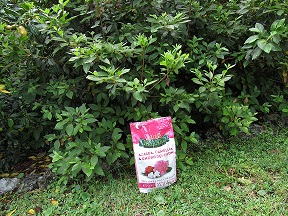How one can Fertilize Azaleas and Camellias
Fertilize spring-blooming shrubs equivalent to azaleas and camellias correct after they finish flowering. The crops have merely used quite a few sources to provide flowers, and every azaleas and camellias push new flushes of leaves immediately after they bloom, as properly. By the purpose they’re accomplished with all of that growth and train they’ll use just a little little bit of replenishing. Do them a favor by fertilizing with Jobe’s Organics Azalea, Camellia, and Rhododendron fertilizer.
Feed the Soil Not the Crops
Wait, did I not merely inform you to feed your crops? Really, you’re going to feed the soil throughout the crops. Crops get most of the nutritional vitamins that they need in an effort to develop, along with the “giant three” Nitrogen, Phosphorous, and Potassium, from the soil. The pH of the soil impacts whether or not or not the nutritional vitamins will be discovered to crops (amongst completely different points). Azaleas, Camellias, Rhododendrons, Hollies, Blueberries, and gardenias all thrive in soil that has an acidic, or lower pH. Some fertilizers will elevate the pH to the aim the place it is powerful for crops to take up the nutritional vitamins they need. That’s why it’s very important to fertilize with plant meals that may protect final pH ranges for the crops you’re feeding. Jobe’s Organics Azalea, Camellia, and Rhododendron Fertilizer accommodates a mix of nutritional vitamins, minerals, helpful micro organism, and helpful fungi, all particularly formulated for acid-loving crops.

How one can Fertilize Azaleas and Camellias
On a regular basis adjust to directions on the fertilizer bag or label. These directions replicate the current details about safely and appropriately making use of fertilizer to your yard.
When to fertilize
Plan to fertilize Azaleas and Camellias when there is no fast rain throughout the forecast. Whereas you may “water in” the fertilizer, you don’t want it to get washed away in a sudden downpour, because of that may 1) waste your money and a pair of) pollute the waterways. (Even an extreme quantity of pure fertilizer might trigger algal blooms downstream.)
How loads fertilizer to utilize
New bushes and shrubs: Mix one cup of Jobe’s Organics fertilizer with the soil throughout the planting hole sooner than planting.
Established shrubs: Fertilize with 1 cup of fertilizer per foot of division unfold. For example, a 4 foot enormous shrub will need 4 cups of fertilizer.
Established bushes: Measure the trunk diameter at one foot off the underside. Fertilize with three cups per inch of trunk diameter. (That is relevant to camellias—and holly bushes, for that matter.)
The place to make use of the fertilizer
The perfect place to make use of the fertilizer is between 4 inches out from the trunk to the sting of the dripline. (The dripline is the place the branches end.) If there could also be mulch throughout the tree or shrub, take away it sooner than fertilizing.
How one can apply the fertilizer
Sprinkle the fertilizer inside the precise house after which use a soil knife, rake, or hand trowel to calmly rake it into the soil. Completely water the realm that you have fertilized.
Soil organisms and helpful micro organism and fungi in Jobe’s Pure fertilizers will break down the fertilizer into the small elements that the crops can take up by means of the roots. By watering, you may jump-start this course of.

Katie Elzer-Peters
gardens throughout the coastal metropolis of Wilmington, North Carolina. She grows greens and has intensive blended border gardens all by means of her half acre property. She has a Bachelor of Science in Public Horticulture from Purdue Faculty and a Grasp of Science in Public Horticulture from the Faculty of Delaware and the Longwood Graduate Program. Katie has written eight books about gardening for Cool Springs Press.






